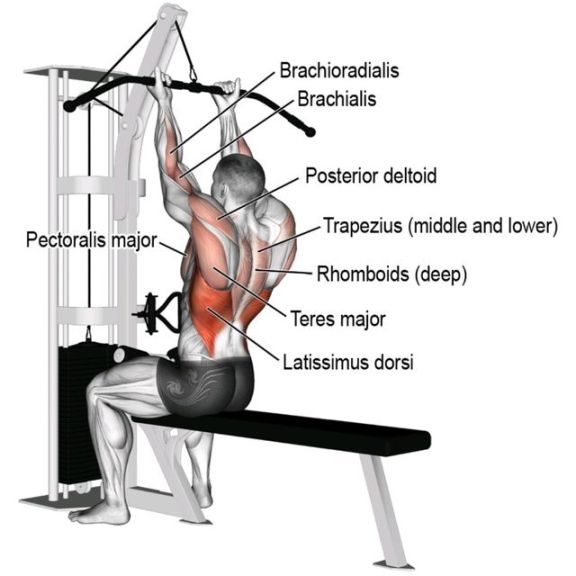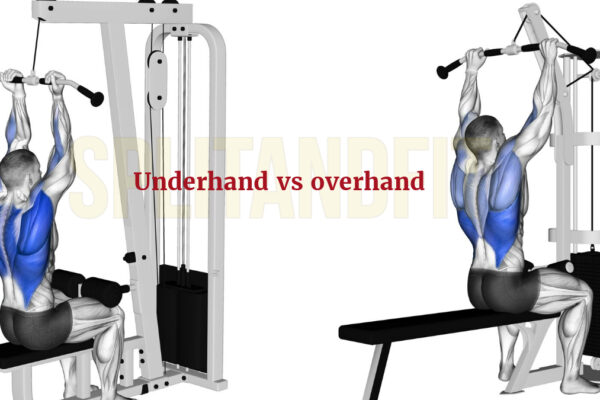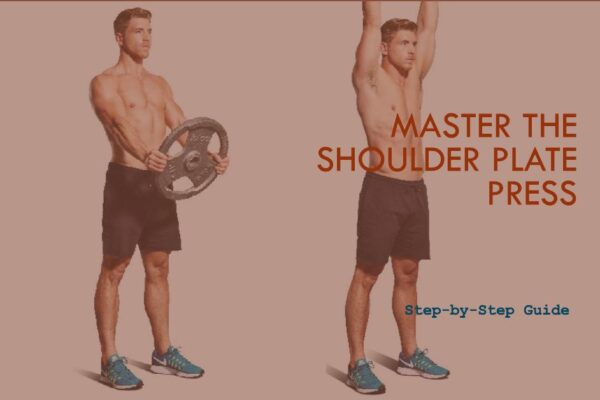Lat pulldowns are popular exercises for those looking to build strength and muscle in their back and arms. There are several variations of this exercise, including close grip and reverse grip lat pulldowns. These two variations may seem similar, but they target different muscles and have different benefits.
In this article, we will provide a comprehensive comparison between the close grip and reverse grip lat pulldown exercises to help you decide which one is best for your fitness goals.
What is Lat Pulldown
The Lat Pulldown is a popular exercise performed in strength training and bodybuilding. It primarily targets the latissimus dorsi muscles, commonly known as the lats, which are located in the upper back. This exercise involves pulling a bar or handle down towards the chest while seated, effectively engaging the back muscles and promoting upper body strength and development. There is a common question people ask which grip is better for execution as a Fitness expert I suggest that
The optimal grip for lat pulldowns depends on your specific objectives. If you’re aiming to enhance lat strength or size, or if you’re working to improve your bicep performance, a reverse grip would be more advantageous. On the other hand, a close grip is more suitable for individuals who want to focus on their mid and upper back or boost their overall back strength.
Difference Between Close Grip vs Reverse Grip Lat Pulldown
The key differences between Close Grip vs Reverse Grip Lat Pulldown are listed below.
| Aspect | Close Grip Lat Pulldown | Reverse Grip Lat Pulldown |
|---|---|---|
| Grip Position | Hands are closer than shoulder-width apart, palms facing towards you. | Hands are shoulder-width apart, palms facing away from you. |
| Equipment | Lat pulldown machine with a close-grip bar attachment. | Lat pulldown machine with a standard bar attachment. |
| How You Execute Each | Sit down on the machine and grab the close-grip bar with palms facing towards you. Pull the bar down towards your chest while keeping your torso stationary. | Sit down on the machine and grab the standard bar with an underhand grip, palms facing away from you. Pull the bar down towards your upper chest while keeping your torso stationary. |
| Muscles Used | Primarily targets the latissimus dorsi (lats), but also works the middle back, biceps, and shoulders. | Primarily targets the lower lats, but also works the upper back, biceps, and forearms. |
| Weight Used | As this exercise allows for more bicep involvement, typically a heavier weight can be used compared to the reverse grip. | Due to the increased demand on the forearm muscles, typically a lighter weight is used compared to the close grip. |
| Range of Motion | Typically allows for a shorter range of motion due to the close grip. | Allows for a longer range of motion due to the underhand grip. |
| Difficulty Level | Generally easier to perform as it allows more bicep involvement. | Slightly harder to perform due to the increased demand on the forearm muscles. |
| Form | Pull the bar down to the chest while keeping the torso stationary. | Pull the bar down to the upper chest while keeping the torso stationary. |
| Benefits | With higher demand on forearm strength, potentially less weight can be lifted. | Better emphasis on lower lats, improved range of motion. |
| Drawbacks | Shorter range of motion, less emphasis on lower lats. | Higher demand on forearm strength, potentially less weight can be lifted. |
Remember, the best choice between these two exercises depends on your individual fitness goals and physical condition. Always consult with a fitness professional if you’re unsure about which exercise is right for you.
Close Grip Lat Pulldown
The close grip lat pulldown is a strength-training exercise that targets the muscles in your back, particularly the latissimus dorsi (lats). It involves using a cable machine with a close grip attachment, pulling the bar down towards your chest while keeping your elbows close to your body. This exercise helps to develop upper body strength and improve posture.
How To Do It:
To perform the close grip lat pulldown with proper form, follow these steps:
- Set-up:
- Sit on the lat pulldown machine with your knees placed firmly under the pads.
- Adjust the thigh pads so that they provide stability and support during the exercise.
- Grasp the close grip handles with an overhand grip, slightly narrower than shoulder-width apart.
- Keep your back straight and your chest up throughout the exercise.
- Execution:
- Start with your arms fully extended, and elbows slightly bent.
- Pull the handles down towards your chest by squeezing your shoulder blades together.
- Keep your elbows close to your body and focus on engaging your lats.
- Pause for a moment when the handles are near your chest.
- Slowly return to the starting position, fully extending your arms.
- Breathing techniques:
- Inhale as you extend your arms at the starting position.
- Exhale as you pull the handles down towards your chest.
- Inhale again as you return to the starting position.
Remember to maintain proper form throughout the exercise, engaging your back muscles and avoiding any jerking or swinging motions. Adjust the weight accordingly to ensure you can perform the exercise with control and without compromising your form.
Muscles Targeted by Close Grip Lat Pulldown
The Close Grip Lat Pulldown primarily targets the latissimus dorsi muscles, commonly known as the lats. Additionally, this exercise also engages the muscles in the middle back, biceps, and forearms. By focusing on a closer grip, the emphasis shifts towards the lower portion of the lats and the muscles in the mid-back region, promoting overall back strength and development.

Pros and Cons
Here are the pros and cons of close grip lat pulldown in a tabular format:
| Aspect | Close Grip Lat Pulldown |
|---|---|
| Pros | 1. Targets a wider range of back muscles, including the latissimus dorsi, middle back, biceps, and shoulders. 2. Allows for generally heavier weights to be used due to more bicep involvement. 3. Can help improve grip strength. 4. Easier to execute compared to some other variations due to the grip position. 5. Can improve upper body strength and posture. |
| Cons | 1. Offers a shorter range of motion compared to some other variations. 2. Less emphasis on the lower lats. 3. Over time, may contribute to muscle imbalances if not combined with other exercises. 4. Requires access to a lat pulldown machine with a close-grip bar attachment. 5. Risk of injury if performed with improper form or too heavyweight. |
As always, it’s crucial to maintain proper form during the exercise and adjust the weight as necessary to prevent injury. Always consult with a fitness professional if you’re unsure about the correct form or weight for you.
Tips to Maximize the Results
- Maintain proper form: Keep your back straight, shoulders pulled back, and chest lifted throughout the exercise.
- Focus on the target muscles: Engage your lats by squeezing your shoulder blades together as you pull the bar down.
- Use a challenging weight: Select a weight that allows you to perform the exercise with proper form, but still challenges your muscles.
- Control the movement: Avoid using momentum and instead, focus on a slow and controlled movement both on the way down and up.
- Breathe correctly: Exhale as you pull the bar down and inhale as you release it back up.
- Gradually increase intensity: Over time, increase the weight or number of repetitions to continue challenging your muscles and making progress.
- Incorporate variations: Experiment with different grip widths or hand positions to target your muscles from different angles.
Common mistakes to avoid
- Improper Grip: Ensure that your grip is not too close. Your hands should be shoulder-width apart on the V-bar.
- Excessive Weight: Using too much weight can lead to poor form and potential injury. Start with a lighter weight to ensure correct form, then gradually increase as you get stronger.
- Incomplete Range of Motion: Make sure to fully extend your arms at the start of the movement and pull the bar down to your chest at the end. Not going through the full range of motion can limit the effectiveness of the exercise.
- Using Momentum: Avoid using momentum to pull the weight down. This can lead to improper form and potential injury. Control the weight throughout the entire movement.
- Incorrect Posture: Always keep your back straight and avoid leaning too far back. Leaning back turns the exercise into more of a rowing motion and takes the focus off the lats.
- Not Engaging the Core: Failing to engage your core during this exercise can lead to back strain. Keep your abs tight throughout the movement.
- Rapid Movement: Performing the exercise too quickly can reduce its effectiveness and increase the risk of injury. Slow, controlled movements are key.
Reverse Grip Lat Pulldown
Reverse Grip Lat Pulldown is an exercise that primarily targets the muscles in the back, particularly the latissimus dorsi (lats). It is performed by using a cable machine or a lat pulldown machine with an underhand grip on the bar, pulling it towards the chest while keeping the elbows close to the body. This exercise helps to strengthen and develop the upper back, as well as improve posture and overall upper body strength.
How To Do A Close Grip Lat Pulldown
To perform the reverse grip lat pulldown with proper form, follow these steps:
- Set-Up:
- Sit on the lat pulldown machine and adjust the knee pad to securely anchor your legs.
- Grasp the bar with an underhand grip (palms facing towards you), hands slightly wider than shoulder-width apart.
- Position yourself with your thighs firmly pressed against the thigh pads.
- Keep your back straight and maintain a slight natural arch in your lower back.
- Execution:
- Inhale and brace your core.
- Pull the bar down towards your upper chest by engaging your back muscles.
- Focus on squeezing your shoulder blades together as you pull.
- Lower the bar back to the starting position in a controlled manner, extending your arms fully.
- Breathing Techniques:
- Exhale as you pull the bar down towards your chest.
- Inhale as you return the bar to the starting position.
Remember to start with a weight that allows you to maintain proper form throughout the exercise. Gradually increase the weight as you become more comfortable and confident with the movement.
Muscles Used during Reverse Grip Lat Pulldown
The Reverse Grip Lat Pulldown primarily targets the latissimus dorsi muscles, commonly known as the lats. Additionally, it engages the biceps brachii muscles, rhomboids, and rear deltoids to a lesser extent.

Tips to Maximize the Results
Follow the below steps to maximize the effectiveness of reverse grip lat pulldown
- Maintain proper form: Keep your back straight, chest up, and shoulders down throughout the exercise.
- Engage your lats: Focus on using your lat muscles to pull the bar down towards your chest.
- Squeeze at the bottom: Pause for a moment and squeeze your back muscles at the bottom of the movement.
- Control the weight: Avoid using momentum and control the weight throughout the entire range of motion.
- Gradually increase intensity: Gradually increase the weight or resistance to challenge your muscles and stimulate growth.
Pros and Cons of Close Grip Lat Pulldown
Sure, here are the advantages and disadvantages of reverse grip lat pulldown in a tabular format:
| Aspect | Reverse Grip Lat Pulldown |
|---|---|
| Pros | 1. Targets lower lats more effectively. 2. Provides a greater range of motion due to the underhand grip. 3. Works out the upper back, biceps, and forearms, offering a more comprehensive workout. 4. Can improve grip strength and upper body flexibility. 5. Contributes to better posture and balance. |
| Cons | 1. Typically requires lighter weights due to increased demand on forearm muscles. 2. May be challenging to perform correctly for beginners. 3. Requires access to a lat pulldown machine with a standard bar attachment. 4. Risk of injury if performed with improper form or too heavyweight. 5. Less emphasis on middle back muscles compared to some other variations. |
Remember, maintaining proper form is crucial when performing any exercise, including the reverse grip lat pulldown. Always consult with a fitness professional if you’re unsure about the correct form or weight for you.
Common Mistakes to Avoid
- Poor Posture: Always maintain a straight back during this exercise. Leaning too far back or forward can stress your spine and lead to injury.
- Using Too Much Weight: Using excessive weight can compromise your form and lead to injuries. It’s always better to use a weight that allows you to perform the exercise correctly and comfortably.
- Pulling The Bar Too Low: The bar should be pulled down to about chest level. Pulling it down to your abdomen can strain your shoulders and reduce the effectiveness of the exercise.
- Not Fully Extending Your Arms: Make sure to fully extend your arms at the top of the movement. Partial extensions can limit the range of motion and decrease the effectiveness of the exercise.
- Relying on Momentum: Using momentum to pull the weight down can lead to poor form and potential injury. Ensure you are using your muscle strength to control both the downward and upward movements.
- Grip Position: Your palms should be facing you in a reverse grip. An incorrect grip can lead to decreased effectiveness of the exercise and potential wrist strain.
- Neglecting to Squeeze: For maximum benefit, squeeze your shoulder blades together at the bottom of the movement. Failing to do this will not fully engage your lats.
Frequently Asked Question
Final Thoughts
both the close grip and reverse grip lat pulldown are excellent exercises for targeting the latissimus dorsi, the largest muscle in the upper body. Each variation has its own unique benefits.
The close grip lat pulldown, with its vertical orientation, tends to target the lats more directly and may be better for those looking to develop upper back thickness. It also requires a level of shoulder mobility and stability.
On the other hand, the reverse grip lat pulldown, with its underhand grip, can engage the biceps more effectively and may help improve lower-lat width or sweep. This variation can feel more natural for some people, particularly those with shoulder issues.
As with any exercise, the best choice between close grip and reverse grip lat pulldowns ultimately depends on your individual fitness goals, comfort, and personal preference. It can be beneficial to incorporate both variations into your workout routine to ensure overall muscular balance and development.
Remember, proper form is crucial in performing these exercises to prevent injury and maximize effectiveness. If you’re unsure about your form or need guidance, don’t hesitate to seek advice from a certified fitness professional.
Sources
- “Effects of Grip Width on Muscle Strength and Activation in the Lat Pull-Down.” Journal of Strength and Conditioning Research, 2014. Link
- “The Effect of Grip Width and Hand Orientation on Muscle Activity During Pull-ups and the Lat Pull-Down.” Strength & Conditioning Journal, 2013. Click here
- “A Comparative Electromyographical Investigation of Muscle Utilization Patterns Using Various Hand Positions During the Lat Pull-Down.” Journal of Strength and Conditioning Research, 2002. Click here
- “Grip Width and Forearm Orientation Effects on Muscle Activity During the Lat Pull-Down.” Journal of Strength and Conditioning Research, 2010. Click here
- “Effects of Pre-Exhausting the Biceps Brachii Muscle on the Performance of the Front Lat Pull-Down Exercise Using Different Handgrip Positions.” Journal of Physical Therapy Science, 2014. Click here






Leave a Reply